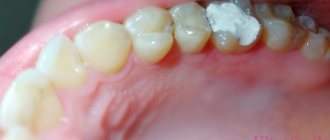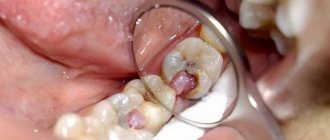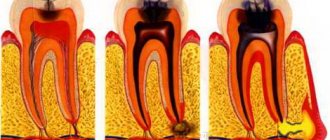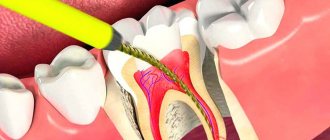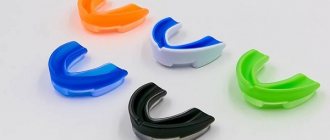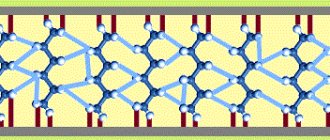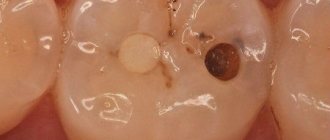It is not always possible to treat a tooth in one visit - if the caries is complicated and the root canals are inflamed, the doctor puts a temporary filling under which he puts medications. It prevents medication from falling out, protects the treated dental cavity from food debris and microbes.
A temporary filling is made of a looser material. It is plastic and does not dissolve in water. For filling, dentin paste, sympath, vinoxol, and zinc-polyacrylate cement are used. The doctor chooses the material, taking into account the diagnosis and the condition of the tooth.
Temporary filling is used for prosthetics, if caries has not reached the nerve, when the nerve is removed. A filling is also installed in the following cases:
- treatment of pulpitis, periodontitis;
- deep caries;
- removal of a tooth root cyst;
- multi-stage therapy;
- making a dental stump inlay when installing a crown.
The period of wearing a temporary filling usually does not exceed 1-1.5 weeks, but sometimes it can be extended up to six months. The dentist determines it exactly.
Sometimes, after installing a temporary filling, patients complain of discomfort and pain. Why does pain occur, how to deal with it?
Why does a tooth hurt after installing a temporary filling?
Pain and discomfort can be a normal reaction, which occurs in 60% of patients, but sometimes pain indicates pathology, inflammation, and complications. After filling, you need to listen to your feelings; if your condition worsens, be sure to consult a doctor.
Installing a temporary filling may cause pain due to treatment and tooth preparation. Natural causes of pain:
- irritation, tooth trauma during cavity treatment, drug installation;
- the effect of medications on the dental pulp;
- the effect of necrotizing agents on the nerve, pulp until the death of nerve endings;
- increased tooth sensitivity, exposure to cold or hot food.
Temporary pain occurs in the first few days after treatment, it is short-lived, the intensity of the sensation gradually decreases, the tooth “aches”, but without excessively painful sensations. How long a tooth hurts after installing a temporary filling depends on the disease: during the treatment of caries it may not appear, but with pulpitis it goes away within one to two weeks. Dental gels and special pastes that reduce tooth sensitivity will help alleviate the condition.
Sometimes, under a temporary filling, severe tearing pain occurs, which intensifies at night. If such sensations are accompanied by other symptoms - swelling of the cheek or gums, numbness of the jaw, increased temperature, this indicates the development of complications. In this case, you need to consult a doctor as soon as possible.
What are temporary fillings?
A temporary filling is created from a special material that does not dissolve in water. The composition of the filling substance and the material for its creation must be selected individually - it all depends on the patient’s diagnosis, as well as on the type and degree of damage to the patient’s tooth.
- Caries under filling
Dentine paste
This material is able to protect the tooth surface from staining with amalgams. It also has the property of repelling moisture, so this material is not used together with liquid medications. It hardens in about two hours, and you can wear such a filling from one week to ten days.
Dentine paste
Vinoxol
This material is very durable, which is why the integrity of such a filling can be maintained for up to six months. This material has antiseptic properties, so such fillings are placed if the cavity of the affected tooth needs to be disinfected. Hardens in about four hours.
Artificial dentin
Another name for this material is zinc sulfate cement. It is set for no more than seventy-two hours. Before installing an artificial dentin filling, the tooth cavity must be thoroughly dried so that the filling mass does not have contact with a humid environment: in this case, the material will not be able to harden.
Artificial dentin
Nice
This substance exists in white and pink colors. Such fillings are most often installed for the treatment of non-pulpless teeth. This filling is hypoallergenic and cannot irritate the oral mucosa.
Nice
Polycarboxylate cement
This material has quite high strength. Also, the mass is biocompatible, so such fillings are installed mainly on baby teeth. In addition, the mass is used for fixing dentures.
About polycarboxylate cement
Blend of oxide, zinc and eugenol
This mixture can not only effectively disinfect the patient’s oral cavity, but also have a sedative effect. This material has high resistance to any mechanical loads. Hardening of the mass occurs within twelve hours.
Possible complications after installing a temporary filling
Pathological processes or complications during treatment can arise due to an allergic reaction of the body, an incorrectly chosen treatment strategy, non-compliance with the period of wearing a temporary filling, or due to loss of medication.
- If the installation of a temporary filling was carried out after placing the drug in the tooth canal, pain may be a sign of an allergy, incorrect dosage of the drug, or incorrectly selected time of exposure. In case of allergies, the doctor replaces the cementing composition or medication.
- If the filling hurts when pressed, this indicates that the periodontal tissue is damaged.
- “Shooting” sharp pain is a sign of purulent pulpitis or tissue inflammation.
- If the pain occurs upon touching and is acute, there may be a piece of dental instrument left in the root canal. The cause of such sensations is also periodontitis.
- Night pain occurs with pulpitis.
Installation of a temporary filling is one of the stages of treatment, and not full-fledged therapy. Over time, such filling material falls out, food and microbes enter the tooth cavity, which leads to a worsening of the condition and the development of complications. In advanced cases, incomplete therapy can cause tooth loss.
Materials for temporary fillings and operating nuances
The performance characteristics of a temporary filling allow the patient to maintain the usual quality of life for the entire period of its use. Moreover, despite the high adhesion to tooth tissues, it is quite easy to remove when the time comes to move on to the next stage of treatment.
Cement components are used as temporary filling materials, such as:
- artificial dentin, made from zinc sulfate and white clay;
- Vinoxol containing zinc oxide;
- Karyosan, which has additional anesthetic properties, etc.
All these compositions, after hardening, are able to withstand the chewing load, are plastic, and are safe for health. When choosing a composition, the doctor proceeds from the time frame for which the temporary filling is installed. For example, fillings made from Vinoxol can last up to six months.
What to do if your tooth hurts
Discomfort and pain in the first days after the procedure are normal. If pain persists, you should consult a doctor. He will perform diagnostics and give recommendations.
If it is impossible to see a dentist, the following measures will help alleviate the condition:
- taking analgesics - Ketorola, Naiza, Analgin: these medications will relieve pain;
- rinsing the mouth with herbal infusions based on chamomile, sage, eucalyptus: the plant material is poured with boiling water, left for about an hour, cooled and filtered;
- rinsing the mouth with a solution of soda and salt;
- you can make a lotion from valerian infusion: soak a cotton swab in the infusion, apply to the gum next to the damaged area;
- if swelling has developed as a result of inflammation, antihistamines will help reduce it;
- Gels containing painkillers will help eliminate discomfort.
Important: these are temporary measures designed to alleviate the condition, and not an alternative to going to the doctor. Visit your dentist as soon as possible!
When to see a doctor
If a tooth under a temporary filling constantly hurts, and the pain is bursting in nature and intensifies at night or during the day, you need to consult a dentist as soon as possible. The doctor examines the damaged tooth: if the filling has fallen out, he will put a new one and replace the medication. If the pain is caused by the development of inflammation or infection, the dentist will take action and change the treatment strategy.
You should immediately consult a doctor in the following cases:
- pain is accompanied by a feeling of swelling of soft tissues;
- the gums or cheek turn red, swell, and swelling appears;
- body temperature rises;
- the intensity of pain does not decrease within several days;
- when exposed to high or low temperatures, the pain intensifies;
- signs of general intoxication of the body develop;
- lymph nodes (primarily submandibular) enlarge and become painful on palpation;
- there is an unpleasant odor from the mouth;
- The temporary filling falls out, its tightness is compromised: cracks and chips form in the cementing material.
In such cases, the dentist will open the filling, remove the medicine and any remaining filling material. The doctor will disinfect the hole, clean and dry the root canals. If necessary, seal them with sealer and install a pin. After such treatment, an x-ray is performed - it allows you to evaluate the quality of treatment. Next, the dentist can re-install a temporary filling or change therapeutic methods.
Reasons for installing a filling
Installing such a filling allows the dentist to monitor the effectiveness of the therapy. The presence of a filling can be an indicator of whether all affected parts of the tooth have been removed and whether therapy needs to be repeated.
Important ! If, after the period of wearing the filling, the dental therapy has not yet been completed, in this case the doctor is obliged to exchange it for a new one and continue the therapy.
Thanks to a temporary filling, the doctor can control the treatment process
The most common reasons why a temporary filling is installed.
| Cause | Description |
| Therapy for deep caries | Even an experienced doctor in this case cannot be completely sure that all the affected tooth tissues have actually been removed. That is why, to be on the safe side, a specialist installs a temporary filling on the patient in order to later check the effectiveness of treatment and the tooth’s response to therapy, and in the absence of relapse of the disease, install a permanent filling on the tooth. |
| Removal of the nerve located deep in the tooth, or treatment of its inflammation | Inflammation of the nerves of the tooth is called pulpitis. When it occurs, an inflammatory process occurs in the nerve bundle located deep in the tooth. The nerve is necessary to connect the hard tissues of the tooth with the nervous and circulatory systems. If a patient has deep caries, then in the absence of treatment, the nerve of the tooth is also involved in the development of caries. This phenomenon is very dangerous for the patient, and it can not only cause unbearable pain, but also spread to nearby tissues. When treating pulpitis, the dental nerve is most often removed and after complete cleaning of the tooth, its cavity is closed with a temporary filling. After a few days, the patient must return for a second examination to the dentist, and if the specialist does not detect any complications, the temporary filling is removed and replaced with a permanent one. Until recently, nerve removal was carried out using a completely different method: the root canal of the tooth was cleaned and a small amount of arsenic was placed into the cavity. This substance was needed in order to burn out the affected nerve roots and later remove them without the use of local anesthesia. To completely burn out a nerve, arsenic had to act on it for several days, which is why, so that the substance could not poison the human body, a temporary filling was placed on top of it. At the moment, this method of tooth extraction is outdated and practically not used in dentistry. |
- What to do if a tooth hurts under a filling?

